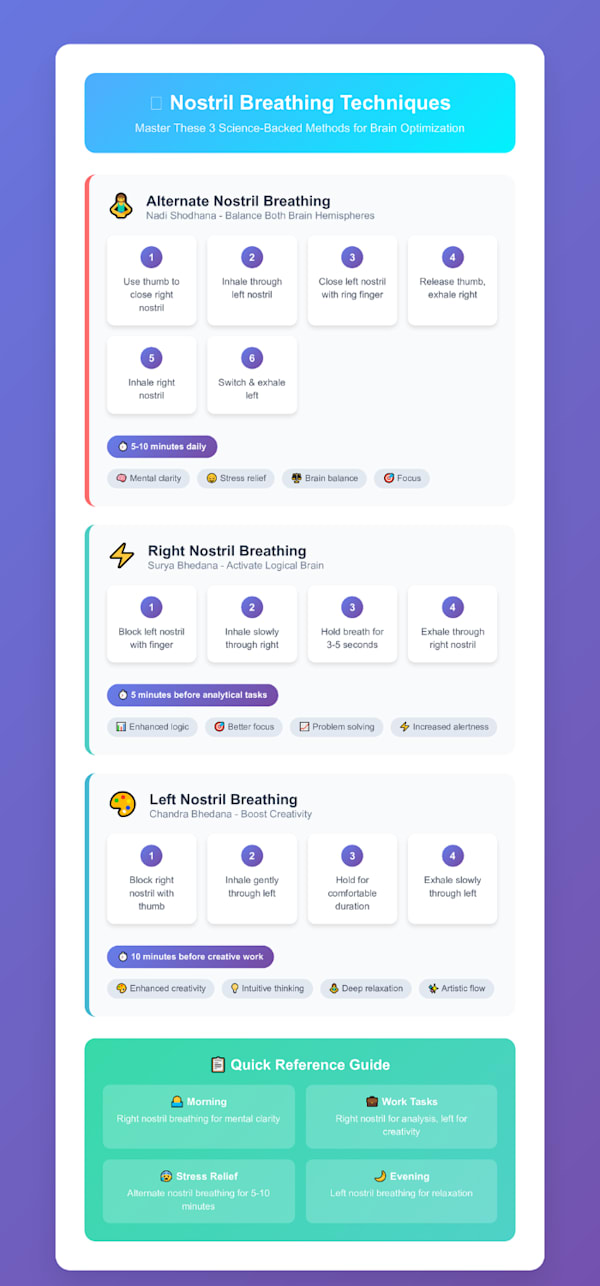⏱️ Estimated Reading Time: 6-8 minutes
Quick Summary
──────────────
- In average nasal cycle alternates every 2-4 hours - controls brain hemisphere activation
- Right nostril breathing = left brain boost - enhances logical thinking & analysis
- Left nostril breathing = right brain boost - increases creativity & intuition
- Stress disrupts natural breathing patterns - causing mental fog & poor focus
- Healthy nasal cycling = balanced nervous system - better mood & energy levels
- Pranayama techniques give manual control - optimize brain states on demand
- Proven methods: alternate nostril breathing, 4-7-8 technique, morning protocols
- Quick results: mental clarity improves within 5-10 minutes of practice
- Long-term benefits: emotional balance, stress management, better sleep quality
- Science-backed: ancient yoga breathing validated by modern neuroscience research
──────────────
Table of Contents:
Introduction
What is the Nasal Cycle and Brain-Breathing Connection?
The 5 Key Discoveries for Optimizing Your Brain Through Nostril Breathing
Best Practices for Nostril Breathing Optimization
Frequently Asked Questions About Nostril Breathing
Conclusion
Scientific Research and Studies on Nasal Cycle
Introduction
Did you know your nose is running a secret rhythm? Thanks to the "nasal cycle," one nostril is usually more open than the other, with the roles switching every few hours. This isn't a sign of sickness—it's a sign your body's autopilot is working!
Understanding nostril breathing techniques and pranayama exercises can revolutionize your approach to mental tasks, stress management, and daily energy optimization. The science behind this ancient wisdom reveals that your breathing pattern directly influences which hemisphere of your brain is most active at any given moment.
In this article, you'll discover:
• How right and left nostril breathing activate different parts of your brain
• Why stress disrupts your natural breathing patterns and mental clarity
• The scientific connection between nasal cycles and nervous system health
• Practical breathing exercises to enhance focus, creativity, and emotional balance
Let's dive into the fascinating world where ancient breathing wisdom meets modern neuroscience.
What is the Nasal Cycle and Brain-Breathing Connection?
The nasal cycle is your body's automatic process of alternating nostril dominance every in a average of 2-4 hours, by directly influencing brain hemisphere activation and cognitive function. This biological rhythm occurs naturally in humans and most mammals, serving as an internal regulatory system for mental performance and nervous system balance.
When your right nostril is dominant, increased airflow activates the left hemisphere of your brain — the analytical, logical processing center. Conversely, left nostril dominance stimulates the right hemisphere of the brain, enhancing creativity, intuition, and spatial awareness. This isn't pseudoscience — it's measurable neurology.
Think of it as your body's built-in performance optimization system — one that's been running 24/7 since birth, automatically adjusting your mental "settings" based on your physiological needs.
Now let's explore how you can harness this natural system for enhanced mental performance.
The 5 Key Discoveries for Optimizing Your Brain Through Nostril Breathing
Discovery 1: Right Nostril Breathing Enhances Analytical Performance
Consciously breathing through your right nostril activates your left brain hemisphere, boosting logical thinking, mathematical processing, and analytical problem-solving abilities. This technique, known in yoga as Surya Bhedana pranayama, stimulates the sympathetic nervous system and enhances alertness levels.
Why it's important: When you have important analytical tasks — like financial planning, data analysis, or logical problem-solving — deliberately practicing right nostril breathing can enhance your cognitive performance.
Best times to use right nostril breathing:
• Before important meetings or presentations
• During analytical work sessions
• When studying technical subjects
• Before making logical decisions
This discovery allows you to strategically time your most demanding analytical work when your brain is naturally optimized for logical processing.
Discovery 2: Left Nostril Breathing Unlocks Creative Flow States
Left nostril breathing activates your right brain hemisphere, stimulating creative thinking, artistic inspiration, and intuitive problem-solving capabilities. This practice, called Chandra Bhedana in traditional yoga, enhances parasympathetic nervous system activity and promotes relaxation-based creativity.
Why it's important: Creative professionals and anyone seeking innovative solutions can use this technique to access flow states more easily.
Optimal applications for left nostril breathing:
• Before brainstorming sessions
• During artistic or creative work
• When seeking innovative solutions
• Before meditation or reflective practices
Understanding this connection gives you a biological shortcut to enhanced creativity and innovative thinking.
Discovery 3: Stress Disrupts Your Natural Brain-Optimization Cycle
Chronic stress interferes with your natural nasal cycle, leaving you stuck in imbalanced breathing patterns that limit cognitive flexibility and emotional regulation. When stressed, most people develop shallow, irregular breathing patterns that disrupt the normal nostril alternation.
Why it's important: This disruption explains why stress makes you feel mentally "off" or cloudy. Your body's automatic brain optimization system gets stuck, preventing the natural switching between analytical and creative mental states. Recognizing this pattern gives you early warning signs of stress buildup.
Signs your nasal cycle is stress-disrupted:
• Consistently breathing through one nostril for hours
• Feeling mentally foggy or "stuck" in thinking patterns
• Difficulty switching between focused and creative tasks
• Irregular energy levels throughout the day
Awareness of this connection offers a new tool for stress management and restoring mental clarity.
Discovery 4: Balanced Nasal Breathing Indicates Optimal Nervous System Health
Individuals with regular, consistent nostril cycling patterns exhibit superior emotional balance, stable energy levels, and improved sleep quality. This biological rhythm serves as a real-time indicator of your nervous system's self-regulation capabilities.
Why it's important: Your nasal cycle acts like a biological health monitor, showing how well your autonomic nervous system is functioning. When this system operates smoothly, you experience better overall wellness, improved stress resilience, and more consistent daily energy.
Indicators of healthy nasal cycling:
• Smooth transitions between nostril dominance every 2-8 hours
• Feeling balanced energy throughout the day
• Natural sleep-wake cycles
• Emotional stability and stress resilience
This discovery transforms your breathing awareness into a powerful health assessment tool.
Discovery 5: Conscious Nostril Control Enhances Mental Performance
Deliberately practicing alternate nostril breathing techniques allows you to manually optimize your brain state for specific tasks and improve cognitive function. This ancient practice, validated by modern neuroscience, enables you to consciously control your mental performance optimization.
Why it's important: Instead of waiting for your natural cycle, you can actively enhance your brain function when needed. This technique, known as Nadi Shodhana, balances both brain hemispheres and enhances overall mental clarity and focus.
Benefits of conscious nostril control:
• Enhanced focus and concentration
• Improved emotional regulation
• Better stress management
• Increased mental flexibility and adaptability
Mastering this technique provides you with an on-demand tool for optimizing your mental state.
Best Practices for Nostril Breathing Optimization
Based on research from leading breathing experts and neuroscientists, here are the most effective practices for harnessing your nasal cycle:
1. Practice the 4-7-8 Nostril Technique
Cover your left nostril, inhale through the right for 4 counts, hold for 7, exhale through the left for 8. This balances both brain hemispheres while reducing stress hormones.
2. Use the Morning Brain Activation Protocol
Start your day with 5 minutes of right nostril breathing to enhance mental clarity and analytical thinking for important morning tasks.
3. Implement the Creative Flow Evening Ritual
Practice 10 minutes of left nostril breathing before creative work or relaxation to activate your right brain and promote innovative thinking.
4. Monitor Your Natural Patterns
Check which nostril is dominant every 2 hours for one week to understand your personal nasal cycle rhythm and identify stress-related disruptions.
5. Use Breathing Apps for Consistency
Incorporate guided nostril breathing sessions using specialized apps to maintain regular practice and track your progress over time.
These evidence-based practices help you work with your body's natural optimization system rather than against it.
Frequently Asked Questions About Nostril Breathing
How long does it take to notice benefits from nostril breathing exercises?
Most people experience immediate effects within 5-10 minutes of practice, including increased mental clarity and reduced stress. For long-term benefits, such as improved emotional balance and consistent energy levels, regular practice for 2-4 weeks typically yields measurable results.
Can nostril breathing techniques replace meditation or other stress management methods?
Nostril breathing techniques complement but don't necessarily replace other wellness practices. They work exceptionally well when combined with meditation, yoga, or mindfulness practices. Many practitioners find that alternate nostril breathing (Nadi Shodhana) enhances their existing meditation routine.
What should I do if one nostril is always blocked or I can't feel the nasal cycle?
Chronic nasal congestion, deviated septum, or allergies can interfere with natural nasal cycling. Consult with an ENT specialist or breathing therapist if you consistently can't breathe through both nostrils. In the meantime, focus on the techniques you can practice and work on overall breathing awareness.
Are there any risks or contraindications for nostril breathing exercises?
Nostril breathing exercises are generally safe for most people. However, those with severe respiratory conditions, recent nasal surgery, or acute sinus infections should consult healthcare providers first. Pregnant women should avoid breath retention techniques and stick to gentle alternate nostril breathing without holding the breath.
Conclusion
Your nose has been running a sophisticated brain optimization system your entire life — you just needed to become aware of it. The science is clear: understanding and practicing conscious nostril breathing exercises can dramatically enhance your mental performance, emotional balance, and overall well-being.
The key takeaways for mastering nostril breathing techniques:
• Right nostril breathing enhances logical, analytical thinking
• Left nostril breathing stimulates creativity and intuition
• Stress disrupts your natural brain-optimization cycle
• Regular nasal cycling indicates optimal nervous system health
• Conscious pranayama practice gives you control over your mental states
By implementing these breathing techniques and monitoring your natural patterns, you gain access to ancient pranayama wisdom validated by modern neuroscience. Your body already knows how to optimize brain function — now you have the knowledge to work with this natural system consciously.
Start your nostril breathing journey today: Choose one technique from this article and practice it for just 5 minutes. Notice the immediate effects on your mental clarity and emotional state. Your brain optimization journey begins with a single conscious breath.
Scientific Research and Studies on Nasal Cycle
Pendolino, A. L., Scarpa, B., & Ottaviano, G. (2019). Relationship Between Nasal Cycle, Nasal Symptoms and Nasal Cytology. American Journal of Rhinology & Allergy, 33(6), 644. https://doi.org/10.1177/1945892419858582
Kahana-Zweig, R., Geva-Sagiv, M., Weissbrod, A., Secundo, L., Soroker, N., & Sobel, N. (2016). Measuring and Characterizing the Human Nasal Cycle. PLoS ONE, 11(10), e0162918. https://doi.org/10.1371/journal.pone.0162918
Kennedy DW, Zinreich SJ, Kumar AJ, Rosenbaum AE, Johns ME. Physiologic mucosal changes within the nose and ethmoid sinus: imaging of the nasal cycle by MRI. Laryngoscope. 1988; 98(9):928-33.
White, D.E., Bartley, J. & Nates, R.J. Model demonstrates functional purpose of the nasal cycle. BioMed Eng OnLine 14, 38 (2015). https://doi.org/10.1186/s12938-015-0034-4
Sinha, Smriti; Mittal, Swati1,; Bhat, Shilpi2; Baro, Geeta2. Effect of Nasal Dominance on Pulmonary Function Test and Heart Rate: A Pilot Study. International Journal of Yoga 14(2):p 141-145, May–Aug 2021. | DOI: 10.4103/ijoy.IJOY_115_20
Tahamiler R, Yener M, Canakcioglu S. Detection of the Nasal Cycle in Daily Activity by Remote Evaluation of Nasal Sound. Arch Otolaryngol Head Neck Surg. 2009;135(2):137–142. doi:10.1001/archoto.2008.537
Written by Sowmiya Sree | Breath Researcher & Author on a series of topics related to Breath
This article is thoroughly researched and fact-checked using peer-reviewed studies and trusted medical resources. Last updated: June 2025
Note: This article is for informational purposes only and does not constitute medical advice. Always consult your healthcare provider for medical concerns.
Photo by Eli DeFaria on Unsplash

